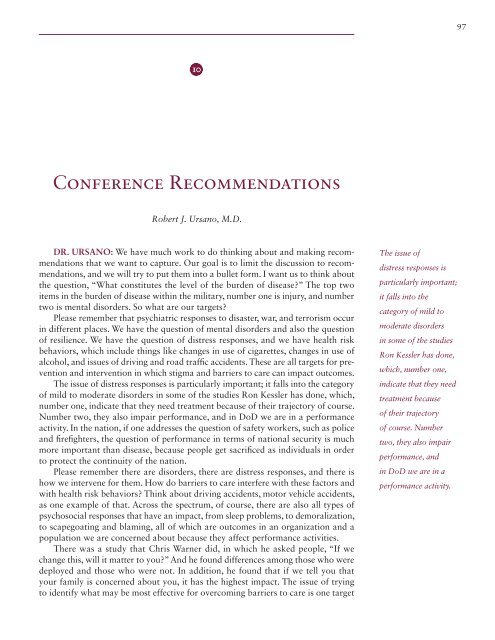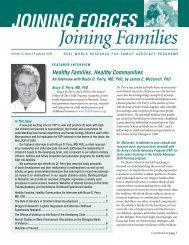stigma and barriers to care - Uniformed Services University of the ...
stigma and barriers to care - Uniformed Services University of the ...
stigma and barriers to care - Uniformed Services University of the ...
You also want an ePaper? Increase the reach of your titles
YUMPU automatically turns print PDFs into web optimized ePapers that Google loves.
Conference Recommendations 97<br />
10<br />
Conference Recommendations<br />
Robert J. Ursano, M.D.<br />
DR. URSANO: We have much work <strong>to</strong> do thinking about <strong>and</strong> making recommendations<br />
that we want <strong>to</strong> capture. Our goal is <strong>to</strong> limit <strong>the</strong> discussion <strong>to</strong> recommendations,<br />
<strong>and</strong> we will try <strong>to</strong> put <strong>the</strong>m in<strong>to</strong> a bullet form. I want us <strong>to</strong> think about<br />
<strong>the</strong> question, “What constitutes <strong>the</strong> level <strong>of</strong> <strong>the</strong> burden <strong>of</strong> disease” The <strong>to</strong>p two<br />
items in <strong>the</strong> burden <strong>of</strong> disease within <strong>the</strong> military, number one is injury, <strong>and</strong> number<br />
two is mental disorders. So what are our targets<br />
Please remember that psychiatric responses <strong>to</strong> disaster, war, <strong>and</strong> terrorism occur<br />
in different places. We have <strong>the</strong> question <strong>of</strong> mental disorders <strong>and</strong> also <strong>the</strong> question<br />
<strong>of</strong> resilience. We have <strong>the</strong> question <strong>of</strong> distress responses, <strong>and</strong> we have health risk<br />
behaviors, which include things like changes in use <strong>of</strong> cigarettes, changes in use <strong>of</strong><br />
alcohol, <strong>and</strong> issues <strong>of</strong> driving <strong>and</strong> road traffic accidents. These are all targets for prevention<br />
<strong>and</strong> intervention in which <strong>stigma</strong> <strong>and</strong> <strong>barriers</strong> <strong>to</strong> <strong>care</strong> can impact outcomes.<br />
The issue <strong>of</strong> distress responses is particularly important; it falls in<strong>to</strong> <strong>the</strong> category<br />
<strong>of</strong> mild <strong>to</strong> moderate disorders in some <strong>of</strong> <strong>the</strong> studies Ron Kessler has done, which,<br />
number one, indicate that <strong>the</strong>y need treatment because <strong>of</strong> <strong>the</strong>ir trajec<strong>to</strong>ry <strong>of</strong> course.<br />
Number two, <strong>the</strong>y also impair performance, <strong>and</strong> in DoD we are in a performance<br />
activity. In <strong>the</strong> nation, if one addresses <strong>the</strong> question <strong>of</strong> safety workers, such as police<br />
<strong>and</strong> firefighters, <strong>the</strong> question <strong>of</strong> performance in terms <strong>of</strong> national security is much<br />
more important than disease, because people get sacrificed as individuals in order<br />
<strong>to</strong> protect <strong>the</strong> continuity <strong>of</strong> <strong>the</strong> nation.<br />
Please remember <strong>the</strong>re are disorders, <strong>the</strong>re are distress responses, <strong>and</strong> <strong>the</strong>re is<br />
how we intervene for <strong>the</strong>m. How do <strong>barriers</strong> <strong>to</strong> <strong>care</strong> interfere with <strong>the</strong>se fac<strong>to</strong>rs <strong>and</strong><br />
with health risk behaviors Think about driving accidents, mo<strong>to</strong>r vehicle accidents,<br />
as one example <strong>of</strong> that. Across <strong>the</strong> spectrum, <strong>of</strong> course, <strong>the</strong>re are also all types <strong>of</strong><br />
psychosocial responses that have an impact, from sleep problems, <strong>to</strong> demoralization,<br />
<strong>to</strong> scapegoating <strong>and</strong> blaming, all <strong>of</strong> which are outcomes in an organization <strong>and</strong> a<br />
population we are concerned about because <strong>the</strong>y affect performance activities.<br />
There was a study that Chris Warner did, in which he asked people, “If we<br />
change this, will it matter <strong>to</strong> you” And he found differences among those who were<br />
deployed <strong>and</strong> those who were not. In addition, he found that if we tell you that<br />
your family is concerned about you, it has <strong>the</strong> highest impact. The issue <strong>of</strong> trying<br />
<strong>to</strong> identify what may be most effective for overcoming <strong>barriers</strong> <strong>to</strong> <strong>care</strong> is one target<br />
The issue <strong>of</strong><br />
distress responses is<br />
particularly important;<br />
it falls in<strong>to</strong> <strong>the</strong><br />
category <strong>of</strong> mild <strong>to</strong><br />
moderate disorders<br />
in some <strong>of</strong> <strong>the</strong> studies<br />
Ron Kessler has done,<br />
which, number one,<br />
indicate that <strong>the</strong>y need<br />
treatment because<br />
<strong>of</strong> <strong>the</strong>ir trajec<strong>to</strong>ry<br />
<strong>of</strong> course. Number<br />
two, <strong>the</strong>y also impair<br />
performance, <strong>and</strong><br />
in DoD we are in a<br />
performance activity.




